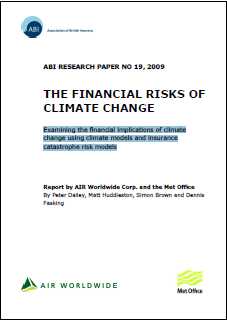Examining the financial implications of climate change using climate models and insurance catastrophe risk models


Executive Summary
This study makes several ground-breaking advances in the area of climate impact assessment by using state-of-the-art modelling techniques combined with expert knowledge in the fields of climate, meteorology, hydrology and actuarial science. The report provides a detailed analysis of the potential impact from a changing climate on insured risk for insurers and other stakeholders through its effects on precipitation-induced inland floods in Great Britain, winter windstorms in the United Kingdom, and typhoons in China.
Potential impacts on pricing, required minimum capital under Solvency II and supplemental capital requirements are also discussed. The main findings, expressed in 2008 £ values and focusing solely on the impact of climate change, are:
- The inland flood component of insurance premiums could increase by around 21% across Great Britain assuming a global temperature rise of 4°C.
- The average annual insured flood losses in Great Britain could rise by 14% to £633 million assuming a global temperature rise of 4°C.
- The insured inland flood loss in Great Britain occurring on average once every 100 years could rise by 30% to £5.4 billion. The insured inland flood loss occurring on average once every 200 years could rise by 32% to £7.9 billion. The estimates assume a global temperature rise of 4°C.
- The average annual insured wind losses in the UK could rise by 25% to £827 million assuming a 1.45° southward shift in storm track across the UK.
- The insured wind-related loss from winter season windstorms in the UK occurring on average once every 100 years could rise by 14% to £7.3 billion. The insured wind loss occurring on average once every 200 years could rise by 12% to £9.7 billion. The estimates assume a 1.45° southward shift in storm track.
- Within Great Britain, the results vary by region. For example, while the average annual insured flood losses for Great Britain as a whole could rise by 14%, regional increases range from less than 10% to nearly 30%, assuming a global temperature rise of 4°C.
- The average annual insured losses from typhoons affecting China could increase by 32% to £345 million; the 100-year loss could increase by 9% to £838 million, and; the 200-year loss could increase by 17% to £1.1 billion. The estimates assume a global temperature rise of 4°C.
Reference
Dailey, P., Huddleston, M. Brown, S., Fasking, D. 2009. The Financial Risks of Climate Change. ABI Research Paper No 19. Available online [http://www.abi.org.uk/Publications/ABI_Publications_The_Financial_Risks_of_Climate_Change_59e.aspx]. Accessed September 2012.
(0) Comments
There is no content